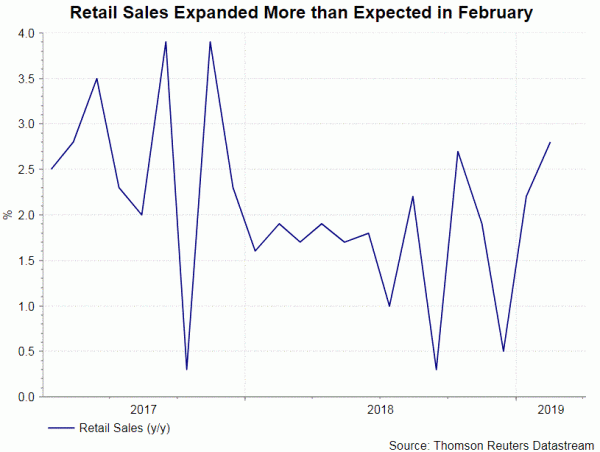Despite some improvements in the economic data released since the March ECB meeting, the overall picture remains mixed and inflation pressure is still soft. There have been plenty of discussions about ECB’s future monetary policy since the last meeting.
First, the central bank made no elaboration on the details after announcing that a new batch of Targeted Long-Term Refinancing Operations (TLTROs) would be launched. Second, members’ comments over the past weeks have given rise to the possibility of a move to a “tiered deposit rate” system in order to save bank profitability. Third, the freshly-released March meeting minutes revealed that although the forward guidance was extended until the end of 2019, some members indeed favored to extend until first quarter of 2020.
With Eurozone’s inflation showing little sign of improvement year to date, and given the officials discussion on the “tiered deposit rate”, it is reasonable for one to speculate that the ECB would further extend the forward guidance, i.e.: pledging that the historically low interest rates would stay for longer.
We expect details of all the above issues, including adjustment to the forward guidance, would be announced in June (the meeting with updated economic projections).
For the meeting next week, ECB would leave the main refi rate, the marginal lending rate and the deposit rate unchanged at 0%, 0.25% and -0.40%, respectively. Meanwhile, it would likely intensify its cautious tone on the downside risk to the economic outlook, while more questions about TLTROs and the tiered deposit rate system are expected at the Q&A session of the press conference.
Targeted Long term Refinancing operations (TLTROs)
Last month, ECB announced the launch of “a new series of quarterly targeted longer-term refinancing operations (TLTRO-III)” from September 2019 to March 2021, “each with a maturity of two years”. Draghi noted that “the operation will help to preserve favourable bank lending conditions”. While the market is awaiting the technical details of the operations, we expect no update until June.
Tiered Deposit Rate System
It appears over the past weeks that the policymakers have become more vocal about the potential detrimental of negative interest rate to banks’ profitability.
Peter Praet, the ECB’s chief economist, indicated in a Bloomberg interview that “the perspective of low rates for longer has triggered the debate about the side effects of a negative rates”. He noted that the central bank is examining the issue of tiering, with some of banks’ excess reserves exempt from the lowest rate, adding that no action is a done deal.
President Draghi also admitted that “if necessary, we need to reflect on possible measures that can preserve the favorable implications of negative rates for the economy, while mitigating the side effects, if any”.
Yet, the feasibility of the tiering system is debatable among the members. For instance, Klass Knot , the hawkish Dutch central bank head, suggested that, while some banks are exempted from negative interest rates, others are not. This is “implicitly telling all banks with a different business model that they will bear these costs for longer”. He added that “there must at least be some evidence” to show that negative rates are “disrupting the impact of monetary policy through their effect on bank profitability” before implementing tools to mitigate it.
Since discussion of the tiering system remains in rather initial stage, we do not expect the ECB to provide any detail at the upcoming meeting.
Forward Guidance
In March, ECB noted that the policy rates would “remain at their present levels at least through the end of 2019”, pushing back the timing from “at least through the summer of 2019” previously.
As noted at the meeting minutes, “a number of members” proposed to extend “the forward guidance through the end of the first quarter of 2020”. They argued that the shift would “provide additional accommodation and would be more in line with the markets’ pricing of a first interest rate increase, compared with survey-based expectations”. They believed that this should provide “a clear easing signal” that is “important in view of the significant downward revisions to the ECB staff projections”.
All in all, the members “agreed to extend the Governing Council’s forward guidance through the end of 2019”, together with announcement on the reinvestment of QE and the TLTROs.
With regard to how frequently the forward guidance should be adjusted, it was concluded that “bringing the calendar-based leg of forward guidance more into line with market expectations of a later date for the first interest rate increase was widely seen as appropriately reflecting the Governing Council’s assessment of the inflation”.
Meanwhile, the state-based leg “automatically implied a shift in rate expectations if the economic conditions for an interest rate increase were not yet in place”.
We expect the ECB to keep the forward guidance unchanged in April. Depending on the economic developments, the members might further delay the timing for the first rate hike in June, when the updated economic projections would be released.


 Signal2forex.com - Best Forex robots and signals
Signal2forex.com - Best Forex robots and signals




